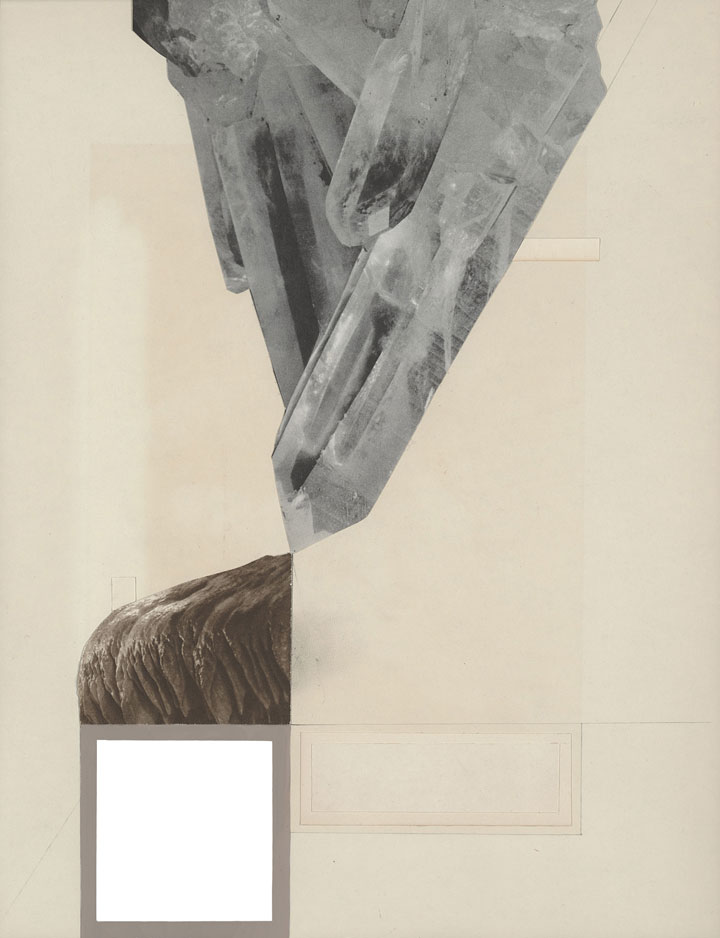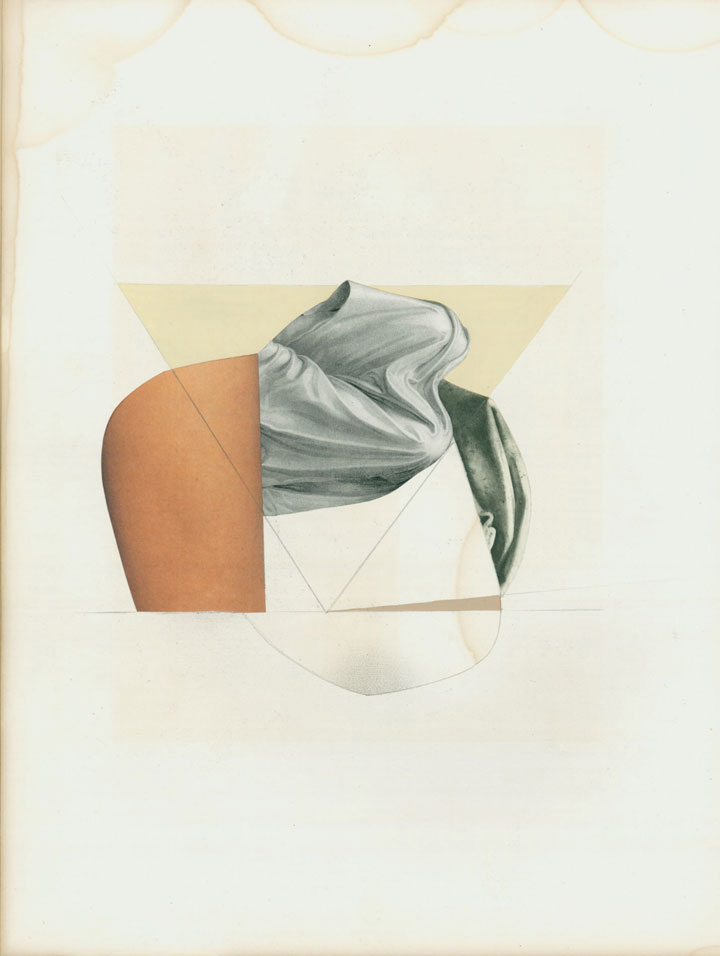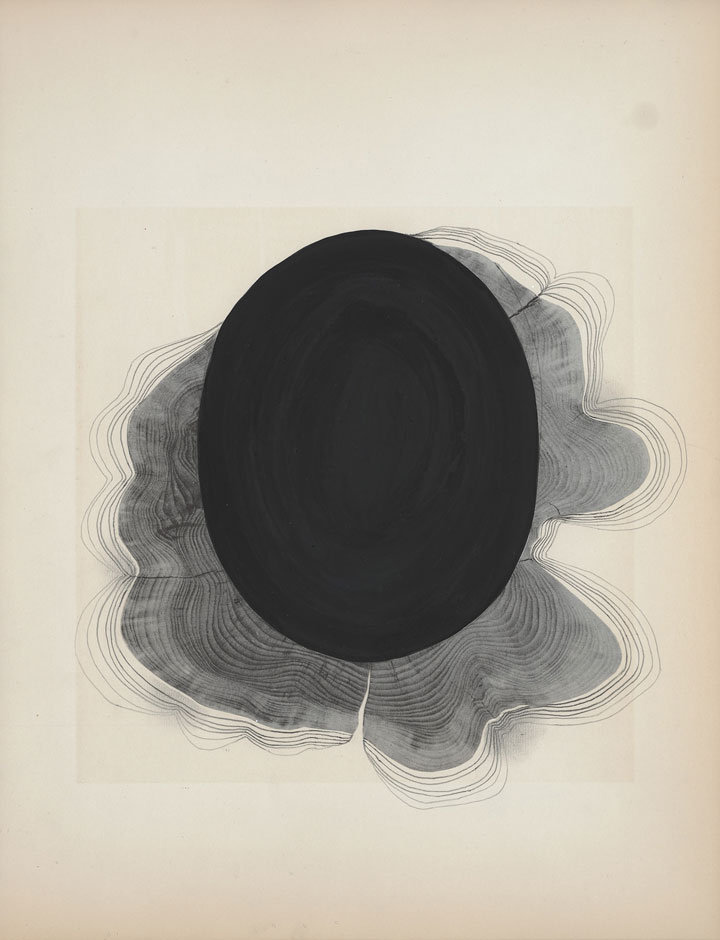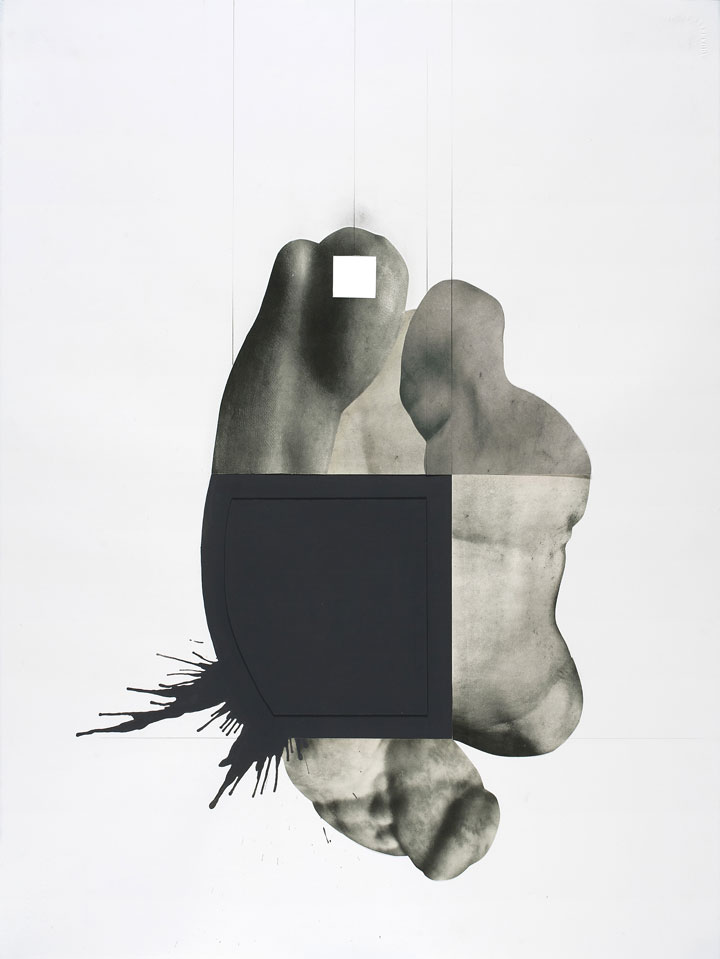Development Intern Emmie Danza interviews Berkeley-based artist Leigh Wells on her sculpture-like drawings and drawing-like sculptures.

Leigh Wells, Remains (12.03.03), 2012. Collage and mixed media on paper, 14 x 10 3/4 inches. Image courtesy of the artist.
Emmie Danza: Throughout your two-dimensional pieces and sculptures, forms layer atop one and another to create seamless meeting points of line, space, and shape. In joining different materials together, do you find that there is a formula you follow? Are there certain materials that you prefer to work with?
Leigh Wells: My mixed media collage-drawings often start with found images which I strip of their original context through editing, cutting, and combining. So far the materials I have chosen to begin my pieces with are found papers, vintage photogravures and mezzotints from books, and the remains of previous projects that I’ve saved in the studio. I combine these with drawn lines (in graphite, ink, or gouache) and flat painted, drawn, or constructed shapes.
I also make a more spontaneous body of sculptural works using readily available materials such as wood, fabric, felt, hardware, and paint. While my collages often read as renderings of invented three-dimensional objects or spaces, when I make my sculptural constructions, I feel as if I’m translating the formal qualities and sensibilities of my two-dimensional work into another dimension.

Leigh Wells, Untitled 11-08-18 (Range), 2011. Seaweed and mixed media, 12 x 19 x 6 inches. Image courtesy of PDX Contemporary Art.
ED: How do you know when you have finished a piece?
LW: Once the main composition is established, what remains to add is subtle, and is done in small steps. I keep things simple, and then stop before complication sets in.
ED: Do you ever feel stuck when working on a piece? If so, how do you move forward?
LW: I can feel stuck sometimes before shifts in the work or before initiating a new body of work. Individual pieces don’t present as much of a problem, and if they do, I set them aside for a while. Inspiration most often comes in the form of reading or seeing art outside the studio.

Leigh Wells , Untitled (11.02.16), 2011. Collage, graphite, and mixed media on paper, 12 3/4 x 9 1/2 inches. Image courtesy of the artist.
ED: Your work is often said to reference reality and fiction. What is it that interests you about the relationship between the known and unknown?
LW: A couple of really important biographical facts come into play here.
First, I was raised in a religion that purported to have very definite answers to the big questions as well as many small, alarmingly specific ones. As a young person, I tested some of these ideas and they seemed wrong to me. I awakened to the idea that the community of adults around me was making life decisions based on faith in a very bizarre set of beliefs while professing absolute certainty.
The parallel in my adult life came when I understood that I had been in a committed relationship for over two decades with a person who had been consistently breaking those commitments. In this case, I had found comfort in certainty, a trust (or faith) that was proven to be completely unfounded. So as a child, I was a skeptic in the face of a certain type of institutional untruth, while as an adult, I became the mistaken believer, taken in by the untruths of an individual.
It is probably these two experiences that have me intrigued by what we can and cannot know for certain about ourselves and others, the physical world, and the nature of reality. For me, theoretical physics, religion, history, and human psychology are all inspirations in their attempts to address these issues.

Leigh Wells, Remains (12.03.17), 2012. Collage and mixed media on paper, 14 x 10.75 inches. Image courtesy of the artist.
ED: Do you think that testing the limits of cultural and societal norms was crucial in your development as an artist? If so, was there a point where you came to a realization regarding your work and its stance on reality and fiction, or is this something that continues to develop throughout your practice?
LW: I wouldn’t really describe myself as having tested limits of cultural and societal norms. Rather, in that early religious context, I tested the religious ideas I was presented with for myself to determine their value and validity for me. This was a mostly private process. The answers I came up with were in opposition to that community, so I left.
The interest in certainty, reality and what can be known stemmed from this early exposure to faith, and was reinforced by the shock of the relationship betrayal. Having the experiences I mentioned before and pushing through those limitations certainly formed me as a person, and fuels some of my interests, and so does affect my inquiry as an artist.

Leigh Wells, Deception (11.10.08), 2011. Collage, graphite, and mixed media on paper, 30 x 22 inches. Image courtesy of the artist.
ED: And finally, what can we look forward to seeing from you in the future? Do you have any upcoming shows?
LW: I am thinking about a new body of work right now that may include more drawing, with less of an emphasis on collage. Subject matter is shifting and will probably become less apparent while I focus more on process and formal concerns. Finding the sweet spot!
I was just included in group shows at PDX Contemporary Art in Portland, and Beginnings Gallery in Brooklyn. I am preparing work to send to group shows in Amsterdam, another gallery in Portland, and one in Nevada. And I especially look forward to a continuing relationship with Gregory Lind Gallery in San Francisco.
You can see more of Wells’s work at her website and In The Make.
